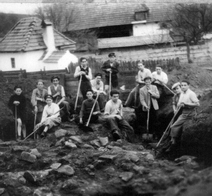The documentation of the Boroșneu Mare site, Covasna County

The Roman Camp from Boroșneu Mare is a well-known objective in the archaeological landscape of Covasna County. The site was discovered almost a century ago and it was the subject of several archaeological research campaigns (surveys or archaeological diggings), having so far a relatively large bibliographical list. Still, a series of discrepancies connected to the dimensions, the dating and the role of the objective, as well as far as identifying the auxiliary unit that stationed here, convinced us to review the entire material collection and scientific documentation found today in the National Szeckler Museum from Sf. Gheorghe, whose specialists were the ones that conducted the researches at the site in the previously mentioned campaigns.
Thus, during the scientific documentation process, we verified 742 museum pieces, out of which 271 were considered to be relevant for our project's goals. The researched material was registered in the collections of the National Szeckler Museum in stages, as it follows:
Year 1911 – donation – Inv. No. 3874-3878
Year 1911 – survey – Inv. No. 4048-4090
Year 1914 – donation – Inv. No. 5593-5602
Year 1947 – survey – Inv. No. 11302-11305
Year 1950 – donation – Inv. No. 13138
Years 1973-1974 – systematic archaeological research – Inv. No. 16656-16682
Together with the roman archaeological material the researchers documented other archaeological materials that were representative for several archaeological periods, such as Eneolithic, Bronze Age, Late Iron Age and the medieval period, in order to establish an evolution in time of the human inhabitation of the plateau on which the Roman Camp lays.
The results of this documentation of the Boroșneu Mare Roman Camp will be published in a work called „The Roman Camp from Boroșneu Mare. The history of the researches”, that will appear in the current issue of ACTA SICULICA (scientific publication of the National Szeckler Museum).